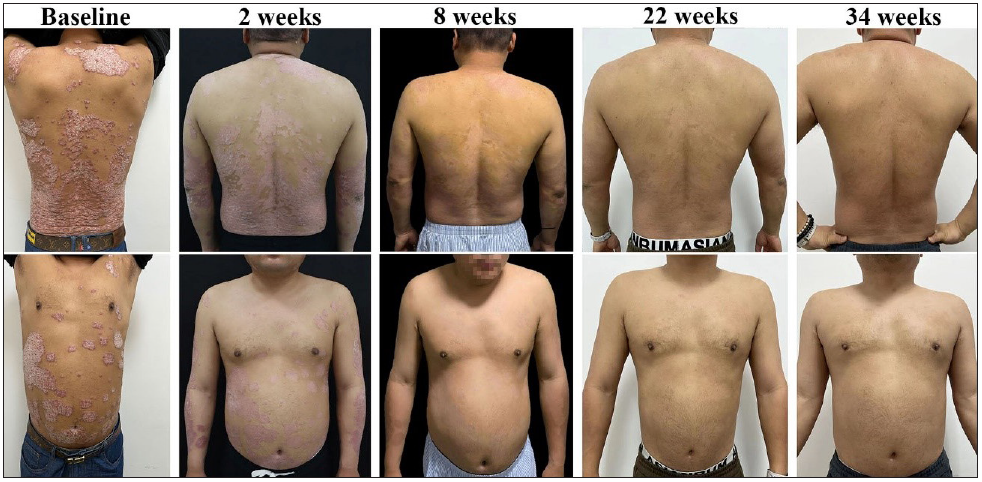Dear Editor,
Managing psoriatic disease in Human Immunodeficiency Virus (HIV) positive patients is particularly challenging due to the complexities of their immune system; however, the safety and efficacy of biologic agents in these patients are still uncertain. Here, we present the case of a 39-year-old Chinese male with a 23-year history of psoriasis, whose lesions worsened after HIV infection and were successfully controlled by guselkumab. Before the HIV diagnosis in 2018, his psoriasis symptoms could be improved by 95% with topical treatment (calcipotriol and corticosteroids ointment) and phototherapy. Despite being on combination antiretroviral therapy (ART) with lamivudine and dolutegravir, his previous therapy gradually lost its efficacy, resulting in papulosquamous plaques covering 43% of his body surface area. Apremilast was also found ineffective after three months of use. In June 2022, he made the first visit to our hospital and laboratory tests indicated hypertension, hyperlipidaemia, fatty liver, and hyperuricaemia, with no other significant abnormalities. His HIV infection was well managed with an undetectable viral load and a CD4 count of 590 cells/μL. After ruling out tumours, hepatitis B, and tuberculosis (TB), he was started on guselkumab, a biologic targeting IL-23, administered subcutaneously, 100 mg at week zero, week four, and every eight weeks thereafter. He continued using topicals for the first month but had stopped phototherapy and apremilast. Remarkable improvement was observed within two weeks, with significant improvement in itching and a reduction in PASI from 35.1 to 20.6. Over an eight-month period, the patient’s skin lesions almost completely resolved [Figure 1]. His CD4 count and HIV viral load remained stable and no adverse effects were observed indicating the combined treatment’s effectiveness and safety [Table 1]. To date, the patient has remained on guselkumab 100 mg every 8–12 weeks and has maintained complete clearance.

Export to PPT
Table 1: Clinical symptoms and parameters tracked during guselkumab treatment.
Duration of medication, weeks 0 2 4 8 22 34 Clinical Symptoms PASI Score 35.1 20.6 20 3.6 0.8 0 PASI Score Decline Rate, % / 41.3 43 89.7 97.7 100 BSA, % 43 43 43 10 7 0 PGA Score 4 3 2 2 0 0 Clinical indicators CD4 T-lymphocyte count, cells/μL 590 670 / 652 593 / HIV load, copies/mL Undetectable Undetectable / Undetectable Undetectable /HIV infection can trigger or worsen psoriasis1 and treatment regimens for HIV-positive psoriasis are generally conservative to avoid destabilising the already compromised immune system. ART is the cornerstone therapy for people living with HIV (PLHIV) as it effectively suppresses viral replication and promotes immune system rebuilding. However, combination therapy with acitretin or apremilast is often necessary for PLHIV with moderate psoriasis. For those severe patients, psoriasis treatment guidelines suggest that biologics can be used with caution.2 Currently, the use of biologic agents is documented in case reports and lacks rigorous clinical trial data. A recent study by Sood et al. reviewed 132 HIV-positive patients with psoriasis who were treated with biologics, including TNF-α inhibitors, IL-17 inhibitors, and IL-23 inhibitors. The majority of patients experienced good clinical outcomes with the highest rates of complete clearance observed on IL-23 inhibitors and the most adverse effects, ranging from mild to fatal infections, associated with TNF-α inhibitors and IL-17 inhibitors.3 ART has improved the epidemiology and the survival rate of HIV, but opportunistic infections such as pneumocystis pneumonia, TB, and cryptococcal meningitis remain the most important causes of death in PLHIV.4 Extensive inhibition of TNF-α and IL-17 increases the risk of tumours and opportunistic infections. Given that China has one of the largest populations of patients with hepatitis B and TB, these two categories of drugs were not our preferred option. IL-23 induces IL-17A/F production by TH17 cells located further upstream of psoriasis pathogenesis and IL-23 inhibitors have demonstrated comparable efficacy and greater safety than IL-17 inhibitors in clinical application.5 The role of IL-23 in HIV invasion and CD4 cells depletion is not well documented. However, it is considered to be a crucial cytokine in those with poor reconstitution of CD4 T cells following ART,6 which means anti-IL-23 therapy may have a positive impact on increasing CD4 cells. Meanwhile, IL-23 inhibitors target the IL-23-p19 subunit, avoiding the inhibition of IL-12-mediated TH1 immune response,7 theoretically making them a suitable choice for psoriasis patients with HIV infection. Early and adequate ART can render HIV a manageable chronic condition, enabling patients with favourable immune profiles (CD4+ T-cell counts >200/cells/μL and stable viral loads) to consider biologics as a therapeutic option for managing psoriasis. While recent reports on IL-23 inhibitors primarily focus on risankizumab, our case suggests that combining ART with guselkumab therapy could also be an effective option for moderate to severe refractory psoriasis in HIV-infected patients who do not respond well to conventional treatments. However, regular follow-up is essential to monitor the adverse effects and changes in immunological profiles.
留言 (0)